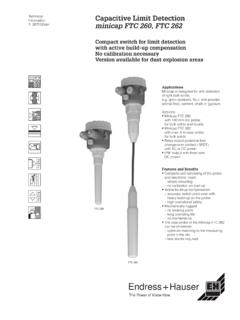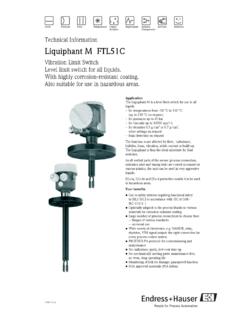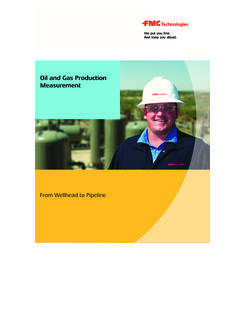Transcription of Technical Information Level Limit Switch nivotester FTL 325 P
1 Technical Information TI 350F/00/en Level Limit Switch nivotester FTL 325 P. With intrinsically safe signal circuit for connection to the liquiphant and Soliphant measuring sensor Applications Benefits at a glance Level Limit detection in liquid tanks and Intrinsically safe signal circuits [EEx ia]. bulk material silos, also in hazardous for problem-free use of measuring explosion areas sensor in explosion hazardous areas For Zone 0 or Zone 20 measuring Highest functional SIL safety (see also sensors Safety Manual SD 111) through: Liquid detection in pipes for dry fault-free PFM technology running protection for pumps line monitoring through to sensor Overspill protection for tanks with corrosion monitoring on tuning fork of combustible or non-combustible liquiphant M measuring sensor liquids harmful to water Compact housing for simple series Two-point control and Level Limit installation on standard rails in Switch detection with one switching instrument cabinet Application in safety related systems Simple wiring using pluggable terminal with requirements for functional safety blocks up to SIL 3 in accordance to IEC 61508 Simple iterative test acc.
2 To WHG by connecting a liquiphant M and S (high temperature): one-touch operation High test depth: from isolating amplifier through to measuring sensor Home Contents Print Exit Safety Manual Functions and system design Measuring principle Signal transmission The intrinsically safe signal input of the nivotester FTL 325 P Limit Switch is galvanically isolated from the mains and the output. The nivotester powers the liquiphant or Soliphant measuring sensors with a two-wire DC loop and receives a frequency which signals whether or not the Limit has been reached. The power supply is superimposed with current pulses (PFM signals) from the measuring transmitter. They have a pulse width of approx. 200 s and a current strength of approx. 10 mA. Signal evaluation The nivotester evaluates the frequency and switches the output relay for the Level alarm. The relay switching state is displayed by a yellow LED on the front panel of the nivotester .
3 Fail-safe circuit By correctly selecting the fail-safe circuit, you can ensure that the relay always works with quiescent current safety. Maximum safety: the relay drops out when the switching point is exceeded (measuring sensor covered), a fault occurs or the power supply fails. Minimum safety: the relay drops out when the switching point is exceeded (measuring sensor covered), a fault occurs or the power supply fails. Function of the Level Limit signal and the current pulse dependent on Level and fail-safe circuit. For application with requirements for functional safety in accordance to IEC 61508 (SIL), please note Safety Manual SD 111F. 2. Safety Manual Function monitoring To increase operating safety, the nivotester is equipped with a function monitoring system. A fault is indicated by a red LED and causes the Level alarm relay in the affected channel as well as the fault alarm to drop out.
4 A fault is signalled when the nivotester receives no more current pulses. This could occur for example in the event of a short-circuit, an interruption in the signalling line to the measuring sensor, vibrator corrosion in the liquiphant , a defect in the measuring sensor electronics or a defect in the input circuit of the nivotester . The function of each channel can be monitored by pressing the test button. The power supply to the sensor is then interrupted. Simplified iterative test for liquiphant M and liquiphant S (HT). Regular function checks are a statutory requirement for overspill protection systems. For the nivotester and the downstream plant sections, there is the possibility of a function test without starting up or removing the sensor. For this reason, the nivotester has a test button on the front panel for each singal input. Pressing the test button interrupts the power supply.
5 When the test button is released, the power supply is returned to the liquiphant and the FEL 57 and the test phase begins. You can find detailed Information on this in KA 147F. [Ex ia]. CH1 CH2. CH3. FTL 325. CH1 CH2 CH3. Two-point control ( s). Two-point control is possible in one tank using the three-channel nivotester ( for pump control). The switching hysteresis is specified by the installation location of the two measuring sensors. 3. Safety Manual Measuring system A simple measuring device consists of one to three measuring sensors, a 1- or 3-channel nivotester and control or signal devices. A liquiphant M, liquiphant S (high temperature) or Soliphant can be used as measuring sensor. 1-channel nivotester FTL 325 P-#1#1. The measuring device of the 1-channel instrument consists of: 1 measuring sensor 1-channel nivotester control or signal devices EX EX. FTL 325 P-#1#1.
6 3-channel nivotester FTL 325 P-#3#3. There are five possible variants of the measuring device in the three-channel instrument. 1. When all three individual channels are used for measuring the Level Limit , the measuring device consists of: 3 measuring sensors 3-channel nivotester control or signal devices EX EX. CH3. CH2. CH1. FTL 325 P-#3#3. 2. When channels CH2 and CH3 are used for two-point control s, the measuring device consists of: 2 measuring sensors 3-channel nivotester control or signal devices 4. Safety Manual 3. When channels CH2 and Ch3 are used for two-point control s and channel CH1 for overspill protection, the measuring device consists of: 3 measuring sensors 3-channel nivotester control or signal devices 4. When channel CH2 is used for measuring the Level Limit with two Level Limit relays and channel CH1 is used for measuring other Level limits , the measuring device consists of: 2 measuring sensors 3-channel nivotester control or signal devices EX EX.
7 FTL 325 P-#3#3. CH3. CH2. CH1. 5. When channel CH2 is used for measuring the Level Limit with two Level Limit relays, the measuring device consists of: 1 measuring sensor 3-channel nivotester control or signal devices EX EX. FTL 325 P-#3#3. CH3. CH2. CH1. Note! As CH1 is not used, the alarm must be switched to "off"! 5. Safety Manual Input parameters Measured variable The Limit signal can be triggered at minimum or maximum height as required. Measuring range The measuring range is dependent on the installation location of the sensors. Input signal Input FTL 325 P: galvanically isolated from power supply and output Protection type: intrinsically safe [EEx ia] IIC. Connectable measuring sensors: liquiphant DL 17 Z, with electronic insert EL 17 Z. liquiphant II FDL 30, FDL 31, FDL 35, FDL 36, with electronic insert FEL 37. liquiphant M FTL 50/51, FTL 50H/51 H, FTL 51 C, with electronic insert FEL 57.
8 liquiphant S (HT) FTL 70/71, with electronic insert FEL 57. Soliphant DM 90 Z, DM 91 Z, DM 92 Z, with electronic insert EM 17 Z. Soliphant II FTM 30 S, FTM 31 S, FTM 32 S with electronic insert FEM 37. Measuring sensor power supply: from nivotester FTL 325 P. Connecting line: two-wire, screening unnecessary Line resistance: max. 25 per wire Signal transmission: pulse frequency modulation (PFM). Output parameters Output signal Relay output per channel: one potential-free Switch contact for the Level alarm Quiescent current safety circuit: minimum/maximum safety selectable with DIL Switch Common fault signal relay: potential-free Switch contact for fault signalling, of which only two contacts are routed out Switch delay: approx. s Switching power of the relay contacts: V~ max. 253 V. I~ max. 2 A. P~ max. 500 VA at cos V max. 40 V. I max. 2 A. P max. 80 W. Life: at least 105 switching operations at maximum contact load Function displays: LEDs for operation, Level alarm and fault Overvoltage category acc.
9 II. to EN 61010. Protection class II (double or increased insulation). Failure signal Level Limit value relay dropped out; fault signal by red LEDs, fault signal relay dropped out Galvanic isolation All input and output channels and relay contacts are galvanically isolated from each other 6. Safety Manual Power supply Electrical connection Terminal blocks The removable terminal blocks are separated into intrinsically safe connections (at top of the instrument) and non-instrinsically safe connections (at bottom of the instrument). Also, the terminal blocks have different colours to make them more easily recognisable. Blue for the intrinsically safe section and grey for the non-intrinsically safe section. This difference helps to ensure safe wiring. Connecting the measuring sensor (at upper, blue terminal blocks). The two-wire connecting line between the nivotester FTL 325 P and the liquiphant or Soliphant measuring sensor can be either a commercially available installation cable or wires in a multi-wire cable for measuring purposes.
10 Line resistance may be a maximum of 25 per wire. If strong electromagnetic interference is expected, from machines or radio devices, a screened cable must be used. Only connect the screen to the ground connection, and not to the nivotester . Installing the measuring sensor in explosion hazardous areas Please observe all local regulations on explosion protection concerning the type and installation of intrinsically safe signal cabling. Please refer to the Safety Instructions XA 133F. for maximum permissible values of capacitance and inductance. Connecting signalling and control devices (at lower, grey terminal blocks). The relay function is dependent on the Level and the fail-safe circuit. If an instrument is connected at high inductance ( contactor, solenoid valve etc.), a spark suppressor must be installed to protect the relay contact. Connecting the supply voltage (at lower, grey terminal blocks).





